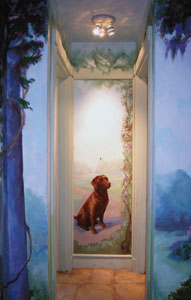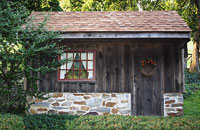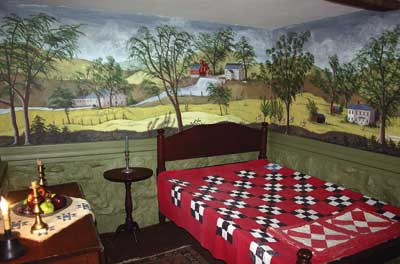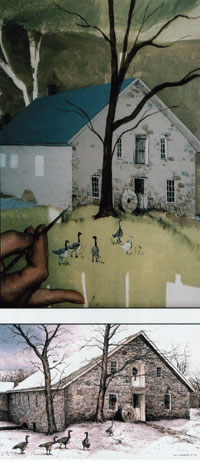House tours, walkabouts in celebration of the nesting instincts that arrive with the equinoxes, often show us how to get the most into four walls. But to get the most out of four walls, in the words of New Jersey muralist and decorative painter Janet Keller Laughlin, it's imperative to establish "a sense of place in a space". Providing this 'sense' is a construct, an environment where the viewer at once finds feet in two worlds; one perhaps where paperwork is filed or the laundry needs tending, but with visual cues announcing another where inspiration and healing might take place, and workaday cares may rightfully disappear from the foreground. To achieve this, an artist needs a command of all of the elements of masterly painting, and particularly with faux (or artificial; from the Old French meaning "false") finishes, the master's touch to randomize himself or herself out of the finished surface. These techniques are the foundation establishing that sense of place, and a means to the discovery of the divine in the mundane.
Establishing a sense of place needn't be overly elaborate. Where murals and trompe l'oeil ("trick of the eye", or, the illusion of 3D reality in a 2-dimensional rendering) fix a depiction and can visually dominate an interior, a space with lighter suggestions of alternate materials and construction can create warmth and stimulate their own kind of transport. Though the construction materials of a room may be ordinary, their application can be rendered extraordinarily: in the faux finisher's art, common materials like sheet rock are painted to evoke the surface Venetian plaster, plywood and sheet rock are transmuted with pigment and deft brushwork and given the solidity of marble. Laughlin, a graduate of Moore College of Art & Design in Philadelphia and graduate study at the Pennsylvania Academy of Fine Art, also of Philadelphia, says that at the heart of the craft of great decorative painting there may be only modest expressive requirements; to visually enlarge a room, or part of a room, to redefine a surface in order to remedy to an architectural flaw, or simply to enliven a blank facade.
Janet Keller Laughlin, originally from Lake Lackawanna in Sussex County, traces the development of her art to a day when, as a young girl she began to experiment with color changes, mostly very bright ones, to her room. Common enough, but by her early teens, her experiments in color had extended to lighting and fabric, to their interplay and varied textures. In these years she began her first formal art training, and remembers she applied all three elements quite consciously at home "to define, and to invent, a space." Her first job, at age 15, transformed a bare expanse of ceiling into a broad, celestial theme of abstract geometries and cosmic vistas illustrating the Four Elements of classical mythology. Her 'Elements' were rendered with the strong, eye-popping Peter Max colors of the day, in what she refers to as "a higher key" to express their fundamental power.

Graduation from Moore and regular employment in commercial art followed, spanning a very active career of 20 years. Eventually, marriage, motherhood, and a continuing interest in decorative painting pulled Janet away from the world of commercial art, in favor of self-imposed deadlines of decorative work done in between the demands of home renovation and child rearing. Completed largely to satisfy her desire to paint and to make the most of surfaces made ready by fresh carpentry, Laughlin's bucolic images gracefully fused new construction and old in her Hopewell, NJ home and studio. Exploring the craft of painting "floorcloths", a tradition of the eighteenth century maritime economy that fashioned inexpensive 'rugs' from the spent, recycled oil cloth sails of tall ships, Janet painted a large floorcloth depicting the hills of her childhood home in Sussex County for her new home in Hopewell.
Since the mid-1980s, from these home-focused projects, portraiture, and environmental transformations including sculpture, garden and landscape design and her paintings of scale ("movable murals"), her creations have found their way into commercial spaces, homes and private collections throughout the country. In her current series of works, Janet's dog Molly is a frequent subject. In one example from her "Rear View Mirror Series", Molly can be seen in tranquil regard of a passing blur of winter roadside in the recursive triplicate perspective of a vehicle's compound right side mirror. And as a central figure in her recent mural installation show at The Hodge House of the Princeton Theological Seminary, Molly appears in beatific luminescence beyond a fanciful trompe l'oeil's recessed hallway (and beneath the painted wall switch of the mural's light source).
Finally, the Skylands themselves are the subject of a Laughlin landscape installation that's part of a private collection in Flanders, in Morris County. Once again, Janet's acrylics revisit the hills of Sussex in this movable mural, complete with verdant, rolling hillsides before a distant pale blue ridge line. Looking down and away, a winding, empty road rises to cross the foreground of the work, while above, a roiling cloudscape is ablaze in the minutes before sunrise. In this pastoral roadside captured in a moment without human travelers, Janet Laughlin preserves the Highlands in a tranquil and imaginary, yet familiar, idyll of deep hue.
Janet Keller Laughlin's work graces private homes and collections in New Jersey, Pennsylvania, and nationwide, and can be seen in public spaces such as the Hopewell Elementary School in Hopewell, and most recently at The Hodge House, Princeton Theological Seminary, Princeton, NJ.
For the admirer of decorative arts, a fine example of contemporary mastery can be seen at "The Cottage", on the farm of Dan and Marty Campanelli. For the trekkers along the Pohatcong Township Tenth Annual House Tour (October 16, 2004), this engaging masterwork of decorative painting, homage, and cultural preservation knits historic Skylands Delaware Valley structures and fanciful landscapes with the visual style of the native itinerant American genius Rufus Porter.
 The
Campanelli's "Cottage", transformed in 2003 from a farm outbuilding's
former antiques and collectibles display area into a re-creation of an
nineteenth century handyman's living space, features the radiant work
of one of America's premier watercolorists, Dan Campanelli. With the
help of his wife Marty, an artist in her own right, visions of familiar
northern New Jersey landmarks populate a rolling, imaginary landscape
on the four walls of the compact, single room structure. Their farm,
once the property of Edward Hunt, a patriot of the Revolutionary War
and keeper of horses for Washington's Continental Army, is a television
and internet-less retreat, a studio and workshop for Dan's award-winning
paintings.
The
Campanelli's "Cottage", transformed in 2003 from a farm outbuilding's
former antiques and collectibles display area into a re-creation of an
nineteenth century handyman's living space, features the radiant work
of one of America's premier watercolorists, Dan Campanelli. With the
help of his wife Marty, an artist in her own right, visions of familiar
northern New Jersey landmarks populate a rolling, imaginary landscape
on the four walls of the compact, single room structure. Their farm,
once the property of Edward Hunt, a patriot of the Revolutionary War
and keeper of horses for Washington's Continental Army, is a television
and internet-less retreat, a studio and workshop for Dan's award-winning
paintings.
The homage of their efforts, is a recreation of the style of painter, inventor, and publisher, Rufus Porter. Porter (1792-1884) is known to have painted portraits while traveling through New Jersey in 1819 and 1820, but is remembered at The Cottage as the naive but masterful painter of murals that were completed in Massachusetts, New Hampshire, and Maine in the 1830s. During the desultory New England journeys of this period in his life, he would occasionally paint for room and board. Several examples of his decorative mural work remain in private homes to this day.
Befitting a creative spirit and inquiring genius, Porter had earned a reputation for moving from project to project, even earning the nickname "grasshopper" for his pursuits. Items from an historic landscape of Nineteenth Century America that can be traced to the imagination of Porter include certain automated firearms, from a patent sold for $100.00 to Samuel Colt for a revolving rifle, to a speculative discussion of lighter-than-air transcontinental airship travel that later found its way into the popular images of Currier & Ives, to the founding (and his typical quick sale) of Scientific American magazine.

Dan and Marty Campanelli have taken Porter's distinctive trees and plantings and arranged them in a landscape that recreates familiar, historic structures in the Skylands, including the Red Mill and Stone Mill of Clinton, the village of Finesville, the Mill at Waterloo Village in Stanhope, and their home, the Hunt Meadow Farm, itself. The sheep and horses that Dan and Marty tend today have been lovingly recreated on the mural's meadows and hillsides. Where Porter's low sun and windy skies gave a stark Yankee charm--and the feeling of a snap in the air--to his originals, the Campanelli's have created a place warm with muted sunshine, soft shadow, and a serene atmosphere where the delicate pale greens of spring predominate.

In the weeks of late summer and fall of 2003, after basic renovations and a new window had been installed, the mural took shape. Dan and Marty's original idea of recreating a Porter mural had its corner-turn early in the creative process, when Marty's idea to depict local landmarks was incorporated into the design. From a base coat in a cream color, the backgrounds were added layer by layer and stencils began to fill in middle and foreground details. Completed November 23rd, 2003, the mural will likely inspire many of its viewers to ask if Rufus Porter had managed to paint any murals during his travels through New Jersey. It's a fair question, dramatically--if fictionally--answered by the exuberant work of the Campanellis.
The 2003 Pohatcong House Tour found the mural nearly complete, this year all is in place, including several interesting period furnishings that evoke a true sense an accomplished workman's living space. Finishing out the room are hewn ceiling beams, an antique rope bed, blanket chest and drop-leaf table, and bucket bench. In July of this year, to reflect the arrival of new members of their flock, Marty and Dan have stenciled new sheep into their mural.